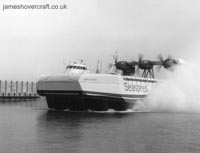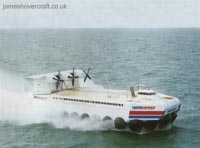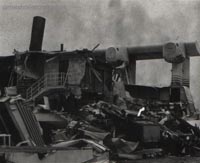Previous: Dover Hoverports 
 Next: AP1-88
Next: AP1-88
- SEDAM N500 story
- SEDAM N500 with Seaspeed gallery
- SEDAM N500 with Hoverspeed gallery
- End of the N500 gallery
The N500 Naviplane was a venture by French company SEDAM, in 1976, who had built smaller models of hovercraft previously namely the N102 and N300. Two production N500s were built, the Ingenieur Jean Bertin and the Côte d'Argent. For a short while, the N500 earned the title of the largest hovercraft in the world, with a displacement when empty of 118 tonnes. The craft were scheduled to operate the Dover to Calais route with Seaspeed, in conjunction with the SRN4s they already had on the route. Their size, and the size of Seapseed's two Super-4s was a driving factor for the creation of the then new hoverport at Dover's western docks.
The first of the N500s, the Côte d'Argent was destroyed by fire during maintenance, after only seven running hours. This dealt SEDAM a great blow, as its now one remaining craft took to the sea for service. Original design capacity for double-decked N500 was 400 passengers and 60 cars, however, eventually this ended up as a reduced 385 passengers and 45 cars - lower than that of the British SRN4 Mk III. Ingenieur Jean Bertin, then, was the only running N500. It underwent major service during 1978 as a result of poor reliability of the engines and hydraulics systems, and famously its inability to climb the Dover hoverpad during bad weather. This pad-climbing inability saw the craft divert to Ramsgate's hoverpad during a storm once, of which I have been sent two photos (in the gallery below).
Hoverlloyd had plans to purchas an N500 but these were eventually scrapped after Seaspeed's craft showed its poor track record. In 1979 the craft experienced complete engine failure off the Boulgne coast, to its three drive engines and two lift engines. Eight hours later passengers were offloaded by helicopter. The 1981 merger between Hoverspeed and Hoverlloyd saw SNCF, the developers of the N500, require a £500,000 modification process to its N500 to try to improve its reliability. However, following this even then, excessive vibrations, propeller pitch errors and skirt problems saw it withdrawn from service following a 30% loss of scheduled flights because of these errors. N500 was no longer supported by the French government and was returned by Hoverspeed to SEDAM in 1983. She was then broken up by mechanical digger.
Ingenieur Jean Bertin was named after French engineer and researcher in the field of "aerotrains" and air-cushions. It was regarded by some, in hindsight, that naming the disastrous craft such a great engineer was very disrespectful!
[Hovercraft Museum, 2007; SEDAM Brochure; Fuller, 2005]
Performance specifications for N500 hovercraft
Source:Hovercraft Museum, 2007; SEDAM Brochure |
| Feature |
Specification |
| Length (m) |
50 |
| Beam (m) |
23 |
| Height (hovering) (m) |
17 |
| Max speed (kts) |
75 |
| Main Engines |
5 x Avco Lycoming Tf 40 marine gas turbines (2 for lift, 3 for propulsion) |
| Engine Power (kW) |
2,386 (continuous), 2,535 (burst) |
| Fuel tank capacity (litres) |
23,380 |
| Endurance (hrs) |
5 |
| Operating Weight Empty (tons) |
118.25 |
| Passenger capacity [intended] |
385 [400] |
| Car capacity [intended] |
45 [60] |
| Operational Limits (Sea state) (m) |
1 - 1.5 |
| Operational Limits (Wind) (Beaufort Scale) |
6 |
The day of stormy weather which brought the N500 to rest at Hoverlloyd's Pegwell Bay hoverport. You can see a Hoverlloyd SRN4 Mk II in the background of the second shot. With strong westerly winds, the N500 had difficulty getting into Dover harbour.
"The N500 needed flat calm and no wind to work, these pictures I took was as it struggled to get on the pad at Pegwell having diverted from Dover owing to strong westerlies. It could not get into the harbour so they opted for Pegwell and finally got onto the pad 2 hours after leaving Calais. We asked them to move it after the passengers departed and they really struggled to get it to one side so that our N4's had a bit of room"
The end of the N500. Ingenieur Jean Bertin being scrapped on the pad at Boulogne [Heatley, 2010]. Some parts were salvaged such as the 6.5m diameter variable pitch propellers, which were compatible with those used on Seaspeed's SRN4 Mk III's, however nothing much was left. You can see in the top photo the two decks of the N500. This was a unique feature of hovercraft at the time








